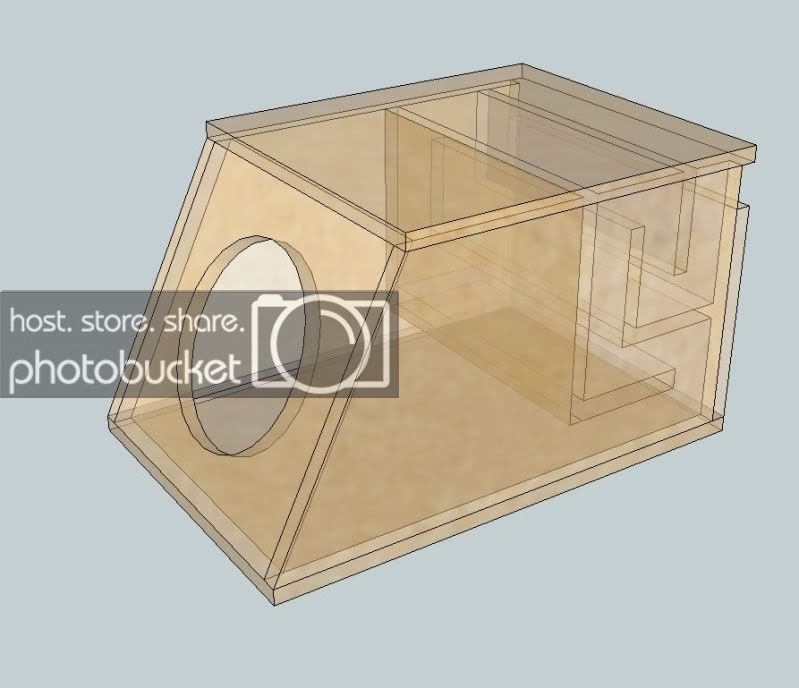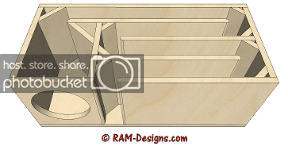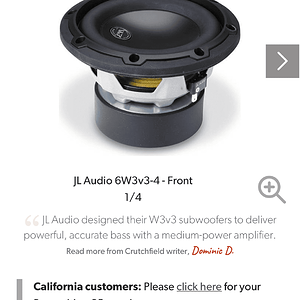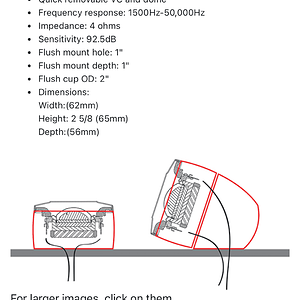T-line boxes
- Thread starter dontbeaprix
- Start date
- Replies 55
- Views 30K
You are using an out of date browser. It may not display this or other websites correctly.
You should upgrade or use an alternative browser.
You should upgrade or use an alternative browser.
-
14Participant count
-
Participant list
Joseph7195 10+ year member
Walkin Tall
I just built this T-Line this past weekend. I am hoping to get it covered and put in my truck soon.


At that point its really just a vented enclosure. You could call is a chambered t-line but itd just be a fancy (and not too accurate IMO) name.
T-lines can be large or small, long or short. Tapered, consistent, or expanding. It all depends on the drivers used and their application.
There is no simply equation for them, or rules of thumb.
T-lines can be large or small, long or short. Tapered, consistent, or expanding. It all depends on the drivers used and their application.
There is no simply equation for them, or rules of thumb.
Moble Enclosurs 10+ year member
Box Designer/Builder
Incorrect. A chambered transmission line is not the same as a vented enclosure with a fancy name. It is actually designed quite differently. In reality, the design of a tline has no similarities to a ported enclosure(basic) at all, even with a compression chamber. Also, it is not based on a simple quarter wave theory, though, back in the 1940s, this was all they had to go from. Now, other factors have been considered that control much more than just a "tuning". In fact, tuning is not even related to a tline, if done properly, nor does quarter wave technology. It is best to rely on half wave resonance if anything. Expansion or tapering the line also gives it much different characteristics than a "ported" box. It does not have to be used for a specific response curve, but can be controlled in most cases to replicate the anechoic response of a driver, which in turn causes a very controlled SQ response, but if that driver is designed for mainly SPL, such as the SA drivers, it can be used efficiently for that as well. Most believe that using a standard quarter wave along with a line area of the square area of the driver, that this will give best results. This cannot be further from the truth, as it is relative to the design goal, but if you were to design one without any knowledge of it at all, using those basics will give you a decent output for SQL. I would never recommend it though.
Half of what you posted agreed with me, the other half seemed a bit misconstrued. A bit like a word problem in math, theres a lot in there that just doesnt pertain to the topic.
You can model a chambered t-line just as you can a vented box, and vice-versa. In the end, they all come down to ducts of a given size or mounting point. Giving them names such as t-line, vented, or what have you is only a vague label to a general sequence of ducts/radiators/etc for human interpretation.
You could model the above enclosure as either (and draw it as either..same specs produce same enclosure, regardless of human alias). They will perform the same, because they are the same box! Just because it was modeled one way doesnt make it something else - its only a means of understanding or simplification.
Especially in situations like this where the difference, if any, is so close and vague the differences are really negligible. If not, Im going to start modeling my ported boxes as tapped/OD horns and charge people as such.
You can model a chambered t-line just as you can a vented box, and vice-versa. In the end, they all come down to ducts of a given size or mounting point. Giving them names such as t-line, vented, or what have you is only a vague label to a general sequence of ducts/radiators/etc for human interpretation.
You could model the above enclosure as either (and draw it as either..same specs produce same enclosure, regardless of human alias). They will perform the same, because they are the same box! Just because it was modeled one way doesnt make it something else - its only a means of understanding or simplification.
Especially in situations like this where the difference, if any, is so close and vague the differences are really negligible. If not, Im going to start modeling my ported boxes as tapped/OD horns and charge people as such.
RAM_Designs 5,000+ posts
SketchUp Master
lolIf not, Im going to start modeling my ported boxes as tapped/OD horns and charge people as such.
Moble Enclosurs 10+ year member
Box Designer/Builder
Negative. It does not all come down to just that. Also, in the audio world, in particular to the engineering side of it, they are not called "ducts". That is more related to the HVAC portion of a related field to area of pressure, such as installing an AC unit that is big enough to supply sufficient pressure for a given room area. Two completely different terms. SO, now that that is out of the way, I have to now mention that since you question my ability to explain such designs, it has to now at this point, as I have figured it to be inevitable anyhow, that when I first came here to this forum, you were asking me about how they work! Not sure you are yet in a position to question my knowledge.Half of what you posted agreed with me, the other half seemed a bit misconstrued. A bit like a word problem in math, theres a lot in there that just doesnt pertain to the topic.
You can model a chambered t-line just as you can a vented box, and vice-versa. In the end, they all come down to ducts of a given size or mounting point. Giving them names such as t-line, vented, or what have you is only a vague label to a general sequence of ducts/radiators/etc for human interpretation.
You could model the above enclosure as either (and draw it as either..same specs produce same enclosure, regardless of human alias). They will perform the same, because they are the same box! Just because it was modeled one way doesnt make it something else - its only a means of understanding or simplification.
Especially in situations like this where the difference, if any, is so close and vague the differences are really negligible. If not, Im going to start modeling my ported boxes as tapped/OD horns and charge people as such.
The names given to each design is unique. The basis of a general transmission line was based from the electrical term in a sense that a coupling has to be designed for efficient operation. Now, a similar way to construct each enclosure is obvious do to the limitations we have in such a small environment(trunk, cabin, etc.) that most of them will start to be construed as identical in some fashion, when trying to maintain a proper acoustical reproduction of the original source.
Human interpretation is not a correct term either. More so, a human "perception". And yes, it does slightly change for each individual, though very similar. Differences can be heard, not so much with increased pressure as with decreased intensity. The above enclosure, yes, will give similar responses, but does not mean they are similar all together. You have to consider the other factors such as the load on the amplifier, and excursion possibilities, etc and many many other factors you have likely stumbled upon on your "google" research of such designs. I never wanted to attack your reasoning nor being another one who is a designer and supporter of the forum, but now it is going far enough for me to have to defend myself in a professional sense so those "competitors" do not give the community a sense of confusion.
Now, since you design as well, it must be mentioned that if you are saying the enclosures are so similar, that no one will notice any differences, first you must understand that the design goal can make one of the biggest differences in this, along with making it seem that what we do, is not any different than designing for a simple "box" persay. So, that will make others question our purpose for being "special" in the field. For this, I would not recommend giving the assumption that what we do is no different than a "standard" design. Even the sealed enclosures, can be modeled and designed much different than a concentration on spec volumes. It's like saying your boxes are more efficient, but designed the same. If that is true, the efficiency is one thing I would investigate. Do not protray that what you do is "simple" enough to be the same as another design, because the construction of a Tline against a BR is much different, even a compressed Tline. They will give similar responses, but some other factors will be different, in some cases much different, between the two, AS LONG AS THEY WERE DESIGNED CORRECTLY(huge key).
So, if differences are negligible, then you are saying paying attention to detail is useless and even your designs are simplified. Differences are not negligible, but some are more important than others. It's like noticing the difference in an HT setup by sitting in different locations...a lot of it has to do with phase, which is not the same as a frequency response curve(the one you mention looks similar). Each factor in the propagation of sound, whether reflected or direct, has their own individual contributions to the overall response. There are different responses to consider, not just a frequency response....such as phase and impulse. which control the quality of sound in most cases. SO, though I do appreciate your reasoning, and do COMPLETELY see where you are coming from, and agree that yes, frequency responses can look very very similar, but the designing of each enclosure SHOULD be different, as each one IS different in its own aspect. It's the limitations that make everything seem so alike.
As far as modeling bass reflexs as horns, there are similarities, but again are done very differently. DO NOT let a "program" make you think otherwise. And its tough to prove as hearing perception also has a factor, along with sensitivity. If you want to stay simple, sure, it works...but I would like to continue making designs that actually are different in their own sense of physical and acoustical construction. The problem is, you can argue this....what I have said! It can be aruged with a lot of sense! But that is because if you do not understand the differences, than ignorance is bliss.
Moble Enclosurs 10+ year member
Box Designer/Builder
I want to mention, to everyone that sees this, that it was inevitable. I am not saying surreal is a bad designer at all. I have actually given him business in the beginning by telling others that he is good at what he does (and have the "likes" from him to prove it). SO, do not think that I am trying to "expose" anyone, but saying that what I "rant" about or explain is misconstrued, and explain to me that all boxes that are physically the same, will perform the same, and stick to a concentration of a single response curve, likely using a program(do not trust programs so much with enclosure design), then I have to send the message. I am a very nice guy, and my purpose here is to help. But if you question my knowledge, or say it is incorrect(indirectly, or directly), or say something that is not fully true, i will be there to fix it. I do not know everything, I am not any different than anyone else here. But I do know audio very extensively, and arguing the points within a forum thread, is very inefficient as the information I use for my designs are not something that can be explained in words, or anything I would like to explain fully, as one, it would take forever, and two, that would be against the purpose of my existence here. if everyone understood the correct information, all the time, what would be the point of me making a living for my family doing what others can do just as well? That is my reasoning, and I have to defend it, even if it involves exposing the truth.
Again, surreal, you are great at what you do from what I have seen! I still feel that way.
Again, surreal, you are great at what you do from what I have seen! I still feel that way.
Moble Enclosurs 10+ year member
Box Designer/Builder
nerd as in knowledge? That is wrong on so many levels, lol. Nah, no nerd **** here. I was on HS football team for 4 years and married a cheerleader (going over 8 years now), //content.invisioncic.com/y282845/emoticons/smile.gif.1ebc41e1811405b213edfc4622c41e27.gif. Also, military spec ops. So, pretty far from nerd. LMAO.nerd RAGE!
I'm surprised, that's your first post in a while that was less than 500 words.nerd as in knowledge? That is wrong on so many levels, lol. Nah, no nerd **** here. I was on HS football team for 4 years and married a cheerleader (going over 8 years now), //content.invisioncic.com/y282845/emoticons/smile.gif.1ebc41e1811405b213edfc4622c41e27.gif. Also, military spec ops. So, pretty far from nerd. LMAO.
Moble Enclosurs 10+ year member
Box Designer/Builder
Yea, it likely was. Seriously, don't be mean for no reason though. I am here to help man. I'm not here to get into the kid talk or arguments of no purpose. So please, stay on topic if you can. Thanks man.I'm surprised, that's your first post in a while that was less than 500 words.
wenn_du_weinst 10+ year member
CarAudio.com Veteran
The ignorant constantly try to discourage the knowledgeable. It ends up poorly for the people trying to learn. That is a huge reason why I won't discuss enclosure design. I will say chambered t-lines are not modeled as ported enclosures. Tapered t-lines are not the same as a horn either. just because something looks similar doesn't make it so.nerd as in knowledge? That is wrong on so many levels, lol. Nah, no nerd **** here. I was on HS football team for 4 years and married a cheerleader (going over 8 years now), //content.invisioncic.com/y282845/emoticons/smile.gif.1ebc41e1811405b213edfc4622c41e27.gif. Also, military spec ops. So, pretty far from nerd. LMAO.
my first post wasn't even directly at you specifically, it was really more about the whole conversation you and surreal were having.Yea, it likely was. Seriously, don't be mean for no reason though. I am here to help man. I'm not here to get into the kid talk or arguments of no purpose. So please, stay on topic if you can. Thanks man.
The worst part is when people who think they're knowledgeable try to act accordingly.The ignorant constantly try to discourage the knowledgeable. It ends up poorly for the people trying to learn. That is a huge reason why I won't discuss enclosure design. I will say chambered t-lines are not modeled as ported enclosures. Tapered t-lines are not the same as a horn either. just because something looks similar doesn't make it so.
Activity
No one is currently typing a reply...
Similar threads
Any of those should do the trick.
- Started by KcContractor
- General Car Audio
- 4
- 954
- 4
- 942
The correct answer is yes, you want both left and right so you get low end information from both channels. It is very common for recording...
- Started by AudioArchitech
- Wiring, Electrical & Installation
- 2
- 1K
only one way to find out. thanks for the input.
- Started by RMDecker
- Wiring, Electrical & Installation
- 5
- 1K
The preamp input on most amps is 10-20k ohms, so you don't really lose voltage. I've run plenty of systems off 2v preamps with no problems.
- Started by toddington
- General Car Audio
- 5
- 940
About this thread
- Start date
- Participants
- Who Replied
- Replies
- 55
- Views
- 30,447
- Last reply date
- Last reply from
- Moble Enclosurs
Latest topics
-
Does rear speakers improves driver audio experience?
- Started by MicraMan
- Replies: 6
-
-
-
BOSS560RBG How to connect a sub, powered or otherwise.
- Started by Carlos_510
- Replies: 3
-



